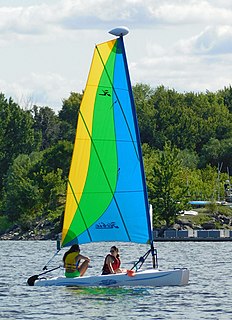Related Research Articles

A catamaran is a multi-hulled watercraft featuring two parallel hulls of equal size. It is a geometry-stabilized craft, deriving its stability from its wide beam, rather than from a ballasted keel as with a monohull boat. Catamarans typically have less hull volume, smaller displacement, and shallower draft (draught) than monohulls of comparable length. The two hulls combined also often have a smaller hydrodynamic resistance than comparable monohulls, requiring less propulsive power from either sails or motors. The catamaran's wider stance on the water can reduce both heeling and wave-induced motion, as compared with a monohull, and can give reduced wakes.

A trimaran is a multihull boat that comprises a main hull and two smaller outrigger hulls which are attached to the main hull with lateral beams. Most modern trimarans are sailing yachts designed for recreation or racing; others are ferries or warships. They originated from the traditional double-outrigger hulls of the Austronesian cultures of Maritime Southeast Asia; particularly in the Philippines and Eastern Indonesia, where it remains the dominant hull design of traditional fishing boats. Double-outriggers are derived from the older catamaran and single-outrigger boat designs.
A beachcat is an off-the-beach class of catamaran ("cat") sailboat.

A sailing hydrofoil, hydrofoil sailboat, or hydrosail is a sailboat with wing-like foils mounted under the hull. As the craft increases its speed the hydrofoils lift the hull up and out of the water, greatly reducing wetted area, resulting in decreased drag and increased speed. A sailing hydrofoil can achieve speeds exceeding twice the wind speed.

A pontoon boat is a flattish boat that relies on floats to remain buoyant. These pontoons contain much reserve buoyancy and allow designers to create massive deck plans fitted with all sorts of accommodations such as expansive lounge areas, stand-up bars, and sun pads. Better tube designs have allowed builders to put ever-increasing amounts of horsepower on the stern. Pontoon boat drafts may be as shallow as eight inches, which reduces risk of running aground and underwater damage, this allows it to come close to shore to pick up and drop off loads.

The Topcat is a one-design sailing catamaran boat class which is divided into several boat sizes.
Thomas David Blackaller, Jr. was a world-champion American yachtsman, America's Cup helmsman, sailmaker, and racecar competitor. He was a two-time world champion in the Star class keelboat, a world champion in the international Six metre class, raced in three separate America's Cup campaigns, and influenced the careers of many other sailors.
The UIM Class 1 World Powerboat Championship is an international motorboat racing competition for powerboats organized by the Union Internationale Motonautique (UIM). It is the premier class of offshore powerboat racing in the world.
The Stiletto 27 is an American trailerable catamaran sailboat that was designed by Bill Higgins and Don Ansley as a racer/cruiser and first built in 1976.
The Gougeon 32 is an American trailerable catamaran that was designed by Jan Gougeon and first built in 1990.

The Hobie Bravo is an American catamaran sailing dinghy that was designed by Hobie Cat in 2000 and first built in 2001. The design is intended for sailing from beaches by one or two people.
The Cheshire 14 is an American catamaran sailing dinghy that was designed by Frank Meldau as a racer and first built in 1962.

The Hobie 14 is an American catamaran sailing dinghy that was designed by Hobie Alter and first built in 1967.
The Trac 14 is an American catamaran sailing dinghy that was designed by Australians Richard and Jay McFarlane as a one-design racer and first built in 1980.
The Nacra 5.2 is an American catamaran sailing dinghy that was designed by Tom Roland as a one-design racer and first built in 1975. Other that the small production run Nacra 36, the Nacra 5.2 was the first Nacra brand boat and established its reputation.
The Isotope is an American catamaran sailing dinghy that was designed by Frank Meldau as a one-design racer and first built in 1962.
The G-Cat 5.0 is an American catamaran sailing dinghy that was designed by Hans Geissler as a one-design racer and first built in 1975.
The G-Cat 5.7 is an American catamaran sailing dinghy that was designed by Hans Geissler as a one-design racer and first built in 1980.
The Prindle 18 is an American catamaran sailing dinghy that was designed by Geoffrey Prindle as a racer and first built in 1977.
A high-aspect-ratio twin-hull vessel refers to a certain design of catamaran vessels with small waterplane area. These vessels are built and used by the Islamic Revolutionary Guard Corps (IRGC) of Iran. Such design is considered relatively rare in military usage.
References
- 1 2 3 Rosbe, Judith Westlund (July 5, 2006). The Beverly Yacht Club. Arcadia Publishing. pp. 128–129. ISBN 9781439617892.
- ↑ "Donan Raven's Sailing Trivia: Little America's Cup book - four side stories". sailingtrivia.ravenyachts.fr.
- 1 2 Zich, Arthur (March 4, 1963). "Two Hulls Are Better Than One". Sports Illustrated .
- ↑ Jones, Theodore A. (May 1963). "Beverly Is a Swingin' Cat". Boating.
- ↑ "1963's Top Performers Under Sail". Boating. 1964.